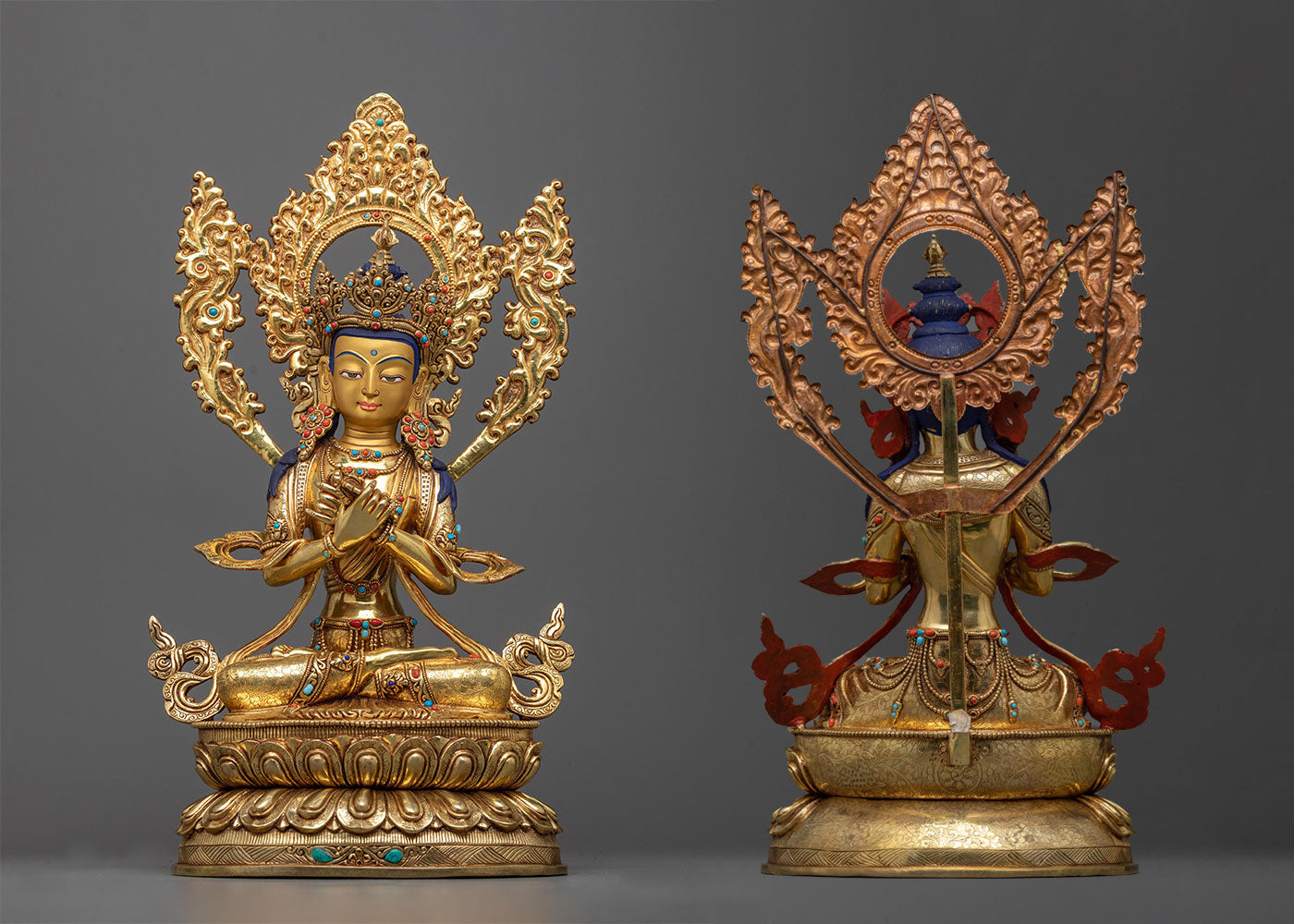Buddha Vajradhara: The Embodiment of Ultimate Reality in Tibetan Buddhism
Vajradhara Buddha, a key figure in Tibetan Buddhism, symbolizes the epitome of the enlightened mind, encompassing the entirety of Buddhahood. Integral to Tantric and Vajrayana traditions, he signifies the utmost manifestation of enlightenment and plays a crucial role in transmitting esoteric teachings.
Key Takeaways
- Vajradhara is a principal figure in Tibetan Buddhism, symbolizing ultimate enlightenment.
- He is central to the Tantric and Vajrayana traditions, embodying the essence of the Dharmakaya.
- The iconography and symbolism of Vajradhara are deeply significant, representing profound aspects of Buddhist teachings.
Origins & Significance: Historical Context and Evolution
Vajradhara, translated as "Bearer of the Thunderbolt" in Sanskrit, appears in Buddhist texts as a cosmic manifestation of the historical Buddha, Shakyamuni. Beyond temporal and spatial constraints, this form embodies Buddhahood's profound and universal dimension.
The evolution of Vajradhara in Buddhist ideology mirrors the progression of Mahayana and Vajrayana Buddhism, transitioning from a focus on the historical Buddha to more transcendent representations.
Evolution of Buddhist Thought
| Period | Development |
| Early Buddhism | Focus on Historical Buddha Shakyamuni |
| Mahayana Buddhism | Emergence of Celestial Buddhas and Bodhisattvas |
| Vajrayana Buddhism | Introduction of Tantric Deities like Vajradhara |
TheologicalImplications and Dharmakaya
Within Vajrayana Buddhism, Vajradhara holds a position of reverence as the primordial Buddha, encapsulating the Dharmakaya – the supreme reality and truth body of enlightenment. This formless and limitless facet of Buddhahood transcends conventional perception, symbolizing the intrinsic purity and potential for enlightenment present within all beings.
Three Bodies of the Buddha (Trikaya)
| Body | Description |
| Dharmakaya | Truth Body, representing ultimate reality |
| Sambhogakaya | Enjoyment Body, representing the bliss of enlightenment |
| Nirmanakaya | Emanation Body, representing physical forms like Shakyamuni Buddha |
Iconography and Symbolism
Click here to view our Buddha Vajradhara Statue
- Detailed Physical Depictions
Vajradhara is commonly portrayed in the contemplative posture of dhyanasana, adorned with intricate jewels and attire befitting a bodhisattva. With a vajra (thunderbolt) in the right hand and a bell (ghanta) in the left, he signifies the harmonious fusion of wisdom (prajna) and compassion (karuna). The blue hue he dons visually conveys the vastness and boundlessness of the sky, symbolizing the infinite nature of his wisdom and influence.
- Symbolic Meanings and Interpretations
Every aspect of Vajradhara's iconography bears profound symbolic significance. The vajra, frequently seen as a diamond or thunderbolt, embodies the indestructible essence of truth and the clarity of an enlightened mind.
Meanwhile, the bell serves as a symbol of wisdom that comprehends the emptiness inherent in all phenomena. The amalgamation of these symbols underscores the connection between knowledge and compassion, a core tenet in Vajrayana Buddhism.
Role in Tantric Buddhism
- Transmission of Tantric Teachings
In the Tantric traditions of Tibetan Buddhism, Vajradhara occupies a distinctive role. Revered as the originator of diverse Tantric teaching lineages, he personifies the direct transmission of esoteric knowledge from teacher to disciple.
This lineage-based conveyance is a foundational element in Vajrayana practice, underscoring the crucial significance of an uninterrupted and direct line of instruction from a qualified master.
- Empowerment and Initiation Ceremonies
Within Vajrayana practices, empowerment (abhisheka) and initiation ceremonies frequently incorporate the visualization of Vajradhara.
These rituals serve as symbolic representations of the impartation of teachings and the activation of latent spiritual potential within the practitioner. Vajradhara's figure assumes a central role, acting as a focal point for connecting with the timeless wisdom of the Buddha.
Significance of Empowerment in Vajrayana
| Aspect | Meaning |
| Empowerment Ritual | Symbolizes the transmission of Tantric teachings |
| Vajradhara Visualization | Connects practitioner to the source of teachings |
| Guru-Disciple Relationship | Embodies the lineage of transmission |
Meditation and Practice
- Visualization Techniques and Spiritual Significance
Vajradhara meditation employs intricate visualization techniques, guiding practitioners to envision themselves as Vajradhara and embody his enlightened qualities. This practice aims to transcend ordinary perception, enabling the experience of the non-dual nature of reality mirrored by Vajradhara.
- The Path to Enlightenment through Practice
Beyond a simple concentration exercise, the meditation on Vajradhara serves as a transformative practice focused on understanding the essence of mind and reality. By assimilating with Vajradhara's enlightened attributes, practitioners endeavor to dissolve the confines of ego and ignorance, forging enlightenment.
Influence and Legacy: Cultural and Artistic Impact
Buddha Vajradhara significantly influences Tibetan Buddhist art and culture, prominently featured in thangka paintings, sculptures, and ritual objects. These artistic expressions serve as conduits for conveying the profound nuances of Tantric teachings. Beyond their aesthetic importance, these representations also function as valuable tools in meditation and instruction, enhancing the understanding and practice of Vajrayana traditions.
Vajradhara in Tibetan Buddhist Art
| Meduim | Purpose |
| Thangka Paintings | Aids in Meditation and Visualisation |
| Sculptures | Revered in Monasteries and Altars |
| Ritual Objects | Used in Tantric Practices and Ceremonies |
Vajradhara provides profound insights into Buddhist philosophy through his deep iconography and symbolism. His influence extends across both traditional and modern contexts, shaping the spiritual journey of numerous practitioners.
In conclusion, the significance of Vajradhara in Tibetan Buddhism is immeasurable. As the embodiment of ultimate reality and the originator of Tantric teachings, he signifies the highest aspiration for those on the path of enlightenment.




